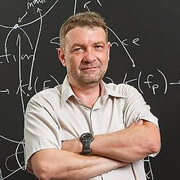This post was suggested by a question on the MathOverflow site. After I answered part of it I noticed that it is related to a recent work of mine of a probabilistic nature. What follows involves no probability. $\newcommand{\bR}{\mathbb{R}}$ $\newcommand{\pa}{\partial}$ As far as the terminology concerning connections, I'll stick to the terminology in Section 3.3. of my book.
Suppose that $M$ is a smooth manifold of dimension $E\to M$ is a real, smooth vector bundle of rank $\nu$ over $M$. We define a pairing on $E$ to be a section of the bundle $E^*\boxtimes E^*\to M\times M$, where $E^*\boxtimes E^*$ is the vector bundle $\pi_1^* E^*\otimes \pi_2^*E^*$, $\pi_i(x_1,x_2)=x_i$, $\forall (x_1,x_2)\in M\times M$, $i=1,2$.
For $x,y\in M$ we can view $B_{x,y}\in E_x^*\times E^*_y$ as a bilinear map
$$ B_{x,y}: E_x\times E_y\to \bR. $$
This induces a linear map
$$ S_{x,y}= S(B)_{x,y}: E_y\to E^*_x. $$
We say that the pairing is nondegenerate if for any $x\in M$ the bilinear map $B(x,x): E_x\times E_x\to \bR $ is nondegenerate. In particular, this induces an isomorphism
$$S_x=S_{x,x}: E_x\to E^*_x.$$
We obtain tunneling operators
$$T(x,y)= S_x^{-1}S_{x,y}: E_y\to E_x. $$
Fix an open coordinate patch $\newcommand{\eO}{{\mathscr{O}}}$ $\eO\subset M$ with coordinates $(x^i)_{1\leq i\leq m}$. Assume $\eO$ is sufficiently small so $E$ trivializes over $\eO$. Suppose that $\newcommand{\be}{\boldsymbol{e}}$ $\underline{\be}(x)=(\be_\alpha(x))_{1\leq \alpha\leq \nu}$ is a local frame of $E$ over $\eO$. We denote by $\newcommand{\ur}{\underline{\mathbb{R}}}$ $\ur_\eO$ the trivial vector bundle $\bR^\nu\times \eO\to\eO$.
The local frame $\underline{\be}$ $\newcommand{\ube}{{\underline{\boldsymbol{e}}}}$ defines a bundle isomorphism $\Phi(\underline{\be}):\ur_\eO\to E_\eO$. In the local frame $\ube$ the tunelling are represented by$\DeclareMathOperator{\Endo}{End}$ $\DeclareMathOperator{\Aut}{Aut}$ a tunneling map
$$T_\ube:\eO\times \eO\to\Endo(\bR^\nu),\;\;T_\ube(x,y)= \Phi_x(\ube)^{-1}T(x,y)\Phi_y(\ube) . $$
Note that $T_\ube(x,x) = \mathbf{1}_{\bR^\nu}$. For $i=1,\dotsc, m$ define
$$\Gamma_i(\ube):\eO\to \Endo(\bR^\nu),\;\;\Gamma_i(\ube,x)=-\pa_{x^i}T_\ube(x,y)\bigl|_{y=x}. $$
We set
$$\Gamma(\ube,x)=\sum_{i=1}^m \Gamma_i(\ube, x) dx^i=-d_x T(x,y)\bigl|_{y=x}\in \Endo\bigl(\;\bR^\nu\;\bigr)\otimes \Omega^1(\eO),$$
where $d_x$ denotes the differential (exterior derivative) with respect to the $x$-variables. $\newcommand{\bsf}{\boldsymbol{f}}$ $\newcommand{ubf}{{\underline{\boldsymbol{f}}}}$ If $\ubf$ is another local frame of $E_\eO$, then there exists a smooth map $g:\eO\to\Aut(\bR^\nu)$ such that
$$\Phi_x(\ubf) =\Phi_x(\ube)\circ g(x),\;\;\forall x\in\eO. $$
Then
$$ T_\ubf(x,y)=g(x)^{-1} T_\ube(x,y) g(y), $$
$$\Gamma(\ubf,x) = -d_x\bigl(\; g(x)^{-1}\;\bigr)\bigl|_{y=x} T_\ube(x,x)g(yx+g^{-1}(x) \Gamma(\ube,x) g(x)=g(x)^{-1}dg(x)+g^{-1}(x) \Gamma(\ube,x) g(x).$$
This proves that the correspondence $\ube\mapsto \Gamma(\ube)$ defines a connection on $E$. We will denote it by $\nabla^B$ and we will refer to it as the connection associated to the nondegenerate pairing $B$.
Let us compute its curvature $R^B$. Using the local frame $\ube$ we can write
$$ R^B= \sum_{1\leq i<j\leq m} R_{ij}(\ube, x)dx^i\wedge dx^j\in \Endo(\bR^\nu)\otimes\Omega^2(\eO), $$
where
$$ R_{ij}(\ube,y)=\pa_{x^i}\Gamma_j(\ube,x)-\pa_{x^j}\Gamma_i(\ube,x)+[\Gamma_i(\ube,x),\Gamma_j(\ube,x)]. $$
Using the local frame $\ube$ we represent $S_{x,y}$ as a $\nu\times \nu$-matrix
$$S_\ube(x,y)=\bigl(\; s_{\alpha\beta}(x,y)\,\bigr)_{1\leq\alpha,\beta\leq \nu},\;\;s_{\alpha\beta}(x,y)=B_{x,y}\bigl(\,\be_\alpha(x),\be_\beta(y)\;\bigr). $$
Then $T_\ube(x,y)=S_\ube(x,x)^{-1} S_\ube(x,y)$, and
$$\Gamma_i(\ube,x)= -\pa_{x^i} S_\ube(x,x)^{-1}\bigl|_{y=x} S_\ube(x,x)-S_\ube(x,x)^{-1} \pa_{x^i}S_\ube(x,y)\bigl|_{y=x} $$
\begin{equation}
= S_\ube(x,x)^{-1}\pa_{x^i} S_\ube(x,x)\bigl|_{x=y}-S_\ube(x,x)^{-1} \pa_{x^i}S_\ube(x,y)\bigl|_{y=x} =S_\ube(x,x)^{-1} \pa_{y^i}S_\ube(x,y)\bigl|_{y=x}.\label{gamma}
\end{equation}
We have
$$\pa_{x^i}\Gamma_j(\ube,x)=\pa_{x^i}\Bigl(\; S_\ube(x,x)^{-1} \pa_{y^j}S_\ube(x,y)\bigl|_{y=x}\;\Bigr) $$
$$ = -S_\ube(x,x)^{-1}\Bigl(\pa_{x^i}S_\ube(x,x)\;\Bigr) S_\ube(x,x)^{-1} \pa_{y^j}S_\ube(x,y)\bigl|_{x=y}+ S_\ube(x,x)^{-1}\pa_{x^i}\Bigl( \; \pa_{y^j}S_\ube(x,y)\bigl|_{x=y}\;\Bigr) $$
\begin{equation}=- S_\ube(y,y)^{-1}\Bigl(\pa_{x^i}S_\ube(x,y)+\pa_{y^i}S_\ube(x,y)\;\Bigr)_{x=y}S_\ube(y,y)^{-1} \pa_{y^j}S_\ube(x,y)\bigl|_{x=y} +S_\ube(y,y)^{-1} \pa^2_{x^iy^j}S_\ube(x,y)\bigr|_{x=y}. \label{1}
\end{equation}
We can simplify the computations a bit if we choose the frame $\ube$ judiciously. Fix a distinguished point in $\eO$ and assume it is the origin in the coordinates $(x^i)$. Note that if $x$ is sufficiently close to $0$, then $T(x,0)$ is an isomorphism $E_0\to E_x$. We set
$$ \bsf_\alpha(x): = T(x,0)\be_\alpha(0). $$
More explicitly
$$\bsf_\alpha(x)=\sum_{\gamma,\lambda} s^{\gamma\lambda}(x)s_{\lambda \alpha}(x,0)\be_\gamma(x), $$
where $(s^{\gamma\lambda}(x))$ is the inverse of the matrix $(s_{\alpha\beta}(x) )$. $\newcommand{\one}{\mathbf{1}}$
In this frame we have $T_\ubf(x,0)=\one$ and we deduce that
\begin{equation}
\Gamma(\ubf, 0)=0.
\label{2}
\end{equation}
On the other hand,
\[
\Gamma_i(\ubf,0)=S_\ubf(0,0)^{-1}\pa_{y^i}S_\ubf(0,y)\bigr|_{y=0}.
\]
We deduce that for this special frame we have
\[
\pa_{y^i}S_\ubf(0,y)\bigr|_{y=0}=0.
\]
Using this in (\ref{1}) we deduce
\begin{equation}
\pa_{x^i}\Gamma_j(\ubf,0)=S_\ubf(0,0)^{-1} \pa^2_{x^iy^j}S_\ubf(0,0),
\label{3}
\end{equation}
and thus
\begin{equation}
R_{ij}(\ubf,0)=S_\ubf(0,0)^{-1}\Bigl(\pa^2_{x^iy^j}S_\ubf(0,0)-\pa^2_{x^jy^i}S_\ubf(0,0)\Bigr).
\label{curv}
\end{equation}
Remark. We say that the pairing $B$ is symmetric if for any $x,y\in M$ and any $u\in Y_x$, $v\in E_y$ we have
\[
B_{x,y}(u,v)=B_{y,x}(v,u).
\]
Observe that the symmetry condition is equivalent to requiring that the tunneling $T_{x,y}: E_y\to E_x^*$ is self-adjoint, i.e., the adjoint $T_{x,y}^*: (E_x^*)^*\to E_y^*$ coincides with $T_{y,x}$.
In this case it is not easy to prove that the bilinear form $\hat{B}\in C^\infty(E^*\otimes E^*)$, $\hat{B}_x=B_{x,x}$, is covariant constant
\begin{equation}
\nabla^B \hat{B}=0.
\label{const}
\end{equation}
Friday, October 31, 2014
Wednesday, October 15, 2014
The Unreasonable Effectiveness of Mathematics in the Natural Sciences
This a good read for any person interested in Math.
The Unreasonable Effectiveness of Mathematics in the Natural Sciences
The Unreasonable Effectiveness of Mathematics in the Natural Sciences
Subscribe to:
Posts (Atom)

